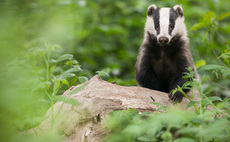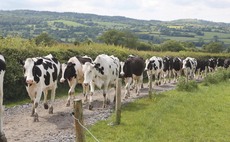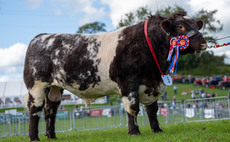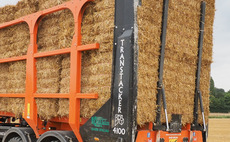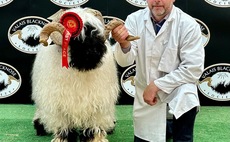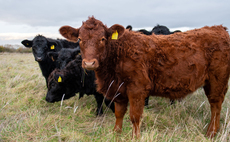
A passion for pedigree cows, a sense of fun along with commitment, and the perfect view distinguish the family behind the prizewinning Larchwood Holsteins in Monmouthshire. Gaina Morgan reports.
Jeff and Sian Jones, together with their daughter Carys and son Dan, have established a business combining commercial production and top type genetics in just eight years.
Storefield Farm, home to Larchwood Holsteins, is close to the M4 at the gateway to Wales, with views across the Bristol Channel to the port of Avonmouth.
At 140 feet above sea level, the land base is 158 acres (64 hectares) with additional rented ground.
The excellent road links make it ideal for welcoming visitors, showing and proximity to the Muller processing plant at Stonehouse.
The herd is already well established on the showing circuit.
Prize-winners
In 2019, Larchwood took reserve champion at the Welsh Dairy Show, with the Excellent 94 Penrikka Dempsey Inka 2.
They took reserve champion at the Vale of Glamorgan Show with Larchwood AFI Lila Z and champion Holstein at Usk Show with Chequers Diego Ebony 3.
They have achieved champion herd in the Monmouthshire CIS herds competition for the last three years. However, Sian says that the loss of the show season has left a huge gap.
She says: "Carys and Dan have been competing at the All Breeds All Britain national calf show for four years with home-bred calves and, in the last two years, we have just
started competing at some of the larger shows with milking animals.
"We competed at the Royal Welsh Show for the first time last year, which was a big step up for us, and we were all looking forward to the 2020 season."
Jeff and Sian moved to Storefield Farm in 1993. They took a break from dairying in 2002, after losing youngstock to foot-and-mouth disease and ran a DIY livery business before re-entering dairying in 2012. A factor was the ‘vibrant milk field' in Monmouthshire, with its location and ease of transport for the major dairies.
Larchwood has been supplying Muller for two years on a liquid contract and is fortunate to have been protected from price fluctuations during the coronavirus pandemic, due to Muller's decision to make all farmers reduce milk production by 3 per cent.
Jeff says: "Cows have always been our interest, so with the children getting older we decided to return to milk production.
"Most people thought we were mad, but we have never looked back."
Progress
Carys has recently joined the farm partnership full-time, following four years working as a rural chartered surveyor with Savills.
She says: "We are looking ahead at how we can make the business more progressive and are in the process of planning a unit for 250 cows.
"Our business is currently performing at a high level for its size when compared to benchmark figures, and the next challenge is to achieve the same management efficiencies while growing the size of the herd."
The milking herd currently comprises 130 cows with 170 followers and all animals are housed throughout the year.
The herd is all year-round calving, with 50 per cent heifers, and is currently achieving a rolling lactation of 11,585kg on twice a day milking.
Sexed semen is used on cows and heifers, with 90 per cent sexed semen on maiden heifers and 70 per cent on cows.
Jeff says: "Sexed semen is getting better all the time. Moving forwards, we want to be in a position where we can sell surplus heifers on a regular basis to add to the farm income.
"We are also driving towards higher production and expansion of the milking herd, which requires plenty of heifer numbers coming into the system."
Carys adds: "Health status is something we have at the forefront of our mind during the expansion process.
Herd health
"We are currently a high health status herd, clear of TB, Johne's, leptospirosis, BVD and IBR, and we want to protect this at all costs.
"Rearing home-bred heifers gives us peace of mind that we are not bringing new pathogens or diseases on to our farm.
"Antibiotic use is also a key consideration for our business. We are currently achieving 3.2Mg/PCU, and are putting protocols in place to reduce this to below 3.0Mg."
Controlling antibiotic use requires meticulous youngstock management.
Sian takes responsibility for the calf unit, where all animals are housed in individual pens before moving into group pens by 21 days. Weaned calves are loose housed and are fed straw and a rearer nut before moving onto the heifer TMR. This consists of straw, maize and a rearer nut.
Production
Bulling heifers, in-calf heifers and the milking herd are housed in deep sand cubicles, optimising cow comfort and udder health.
The mastitis new infection rate of just 4.4 per cent, and a rolling somatic cell count of 74, shows the milking cows are clearly benefiting.
This, combined with top quality forage, provides the ideal platform for cows to maximise production.
Jeff says: "Our forage is something we have really aimed to improve in the last 18 months and a 50:50 mix of 78 per cent dry matter (DM), 12.2 metabolisable energy (ME) maize and 75 per cent DM, 11.7ME Italian ryegrass silage is working well.
"This, combined with brewers grains, protein blend, and minerals, is seeing the cows average 37litres/day with a feed rate of 0.3kg per litre."
With responsibility for choosing the AI bulls, Carys adds that ‘genetics and production go hand in hand'.
Current sires in the flask include Wilder Dalliance, Oh River Syc Crushabull, Siemers Apples Army, Brenland Denver, Toc Farm Fitz, JK Eder Control and Delaberge Pepper. The strength of the maternal cow family is also crucial.
Sires
Carys explains that in the age of genomics, bulls tend to be selected for AI and marketed purely based on their DNA figures.
"Genomics is a great tool for measuring production and fertility traits in particular, but you cannot underestimate the transmitting strength of a cow family," she says.
"Each farm has to adopt a breeding policy that suits their individual system, but, for us, we are definitely looking for a bull with a proven maternal line."
Dan contributes a lot to the farm, in addition to his work as a primary school teacher at an inner city school in nearby Newport, Gwent.
He says competing at Usk Show was a highlight last year, with many members of the public viewing their cattle and wanting to know more about how milk is produced.
He says: "We always try and support local shows, as they are vital at linking the consumer with our industry.
"From school pupils right through to the older generation, it is so important that we as a farming community tell our story".
Investment
Future plans for the family include increasing the farmed acreage, finalising the design for the new cow unit and installing a 24:24 parlour while continuing to improve herd quality.
Investment in some of the best Holstein bloodlines means they have already developed notable families within the herd.
These include the Lila Z, Asset, Rhapsody, Roxy, Juror Faith, Ambrosia, Hood ATM Jessica, D-R-A August, Ammon-Peachy Shauna and Lavish.
The end goal is for every cow to be from a deep pedigree family.
And, of course, they are looking forward to getting back out on the show circuit, seeing friends from across the country and selling the farming message to the public.
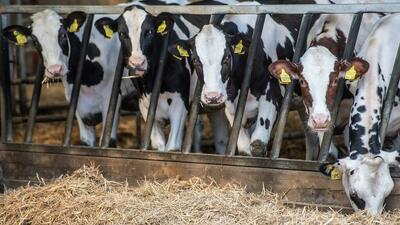

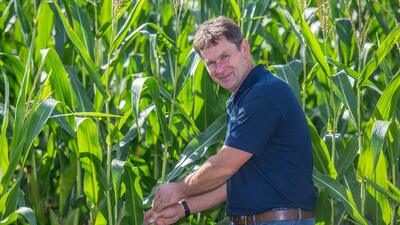
Farm facts
- AI and heat detection is carried out in house, with conception rates of 1.65 straws per service.
- Heifer calves are genomic tested, with figures mainly used for fertility and cell count management.
- Bulls are selected for type, with a strong emphasis on udder traits, locomotion and rump scores.
- Cows are averaging 37litres/day





